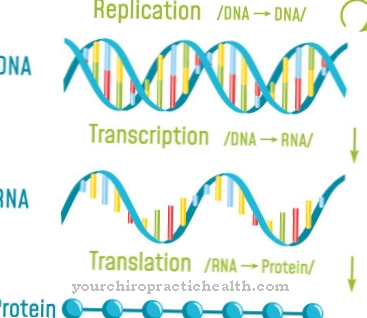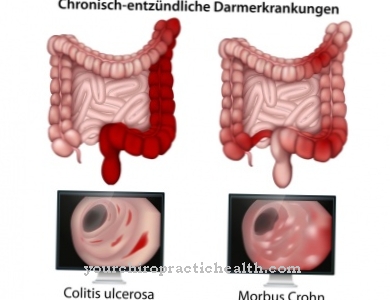Castleman's disease is a very rare, severe disease of the lymph glands that occurs in flares. It was classified by the American pathologist Benjamin Castleman in 1954. The disease occurs in two forms, a less severe and a very rare severe with a poor prognosis.
What is Castleman's Disease?

© Frank - stock.adobe.com
At Castleman's disease it is a lymph gland disease that also affects the surrounding tissue. The lymph nodes grow excessively and form tumors. Depending on whether a lymph node / group of lymph nodes or several individual / several groups are affected, the medicine of M. Castleman differentiates between the unicentric (localized) and the multi-centric form.
The probability of getting the disease is 1 in 100,000 (patients / year). Both sexes are affected. The patients with the severe form are older than those with unicentric Castleman's disease. The latter shows far fewer symptoms than the severe form, which is usually associated with HIV and HHV-8 infection. People with HIV infection / AIDS are at increased risk of developing lymphatic disease. For them, the prognosis is significantly less favorable.
causes
The causes that lead to the localized form of the disease are currently still being discussed controversially.The scientists assume that malignant cells in the patient's body are responsible for an overproduction of IL-6 and IL-10 in the lymph nodes. An inflammatory autoimmune disease, a viral infection other than Human Herpes Virus 8 (HHV-8) or a genetic predisposition could also be the trigger for the milder Castleman's disease.
With her, different variants of the interleukin-6 receptor exist side by side, which accordingly can influence more cells. Since at least 60 percent of patients with the severe course of the disease also have an HHV-8 infection, they develop a viral interleukin that is similar to human IL-6.
Viral IL-6 is also the cause of the cytokine storms typical of the multi-centric form of Castleman's disease: It infects a large number of plasma cells, which are mostly located in the vicinity of the lymphatic follicles.
Symptoms, ailments & signs
In general, the disease is associated with great pain in the affected lymph nodes. In the simpler form of the disease, the B symptoms include involuntary weight loss, fever, and night sweats. In addition, the patient is weak and tired, feels pain in the chest and abdomen - depending on which region is affected by the disease. A slight anemia is often still detectable.
In addition to the B symptoms, patients with the multi-centric form of the disease suffer from nausea, vomiting and loss of appetite and have an enlarged liver and spleen. In addition, there are breathing problems, a tendency to edema, severe protein deficiency, severe anemia, various types of inflammation, and massive thrombopenia (blood platelet deficiency).
Also the POEMS syndrome and - (partly) caused by the simultaneous HIV infection - lymphadenopathy, Kaposi's sarcoma and malignant lymphomas. Depending on the severity and extent of the symptoms, death from multiple organ failure, severe infection and lymphoma can occur.
Diagnosis & course of disease
Castleman's disease must be differentiated from lymphoma and other serious diseases in a differential diagnosis. The severe form in particular is often mistaken for lymphoma. Ultrasound and CT are used to narrow down the size of the affected area. Lymph gland tissue is removed and examined histologically. Blood taken during a disease flare-up shows elevated levels of IL-6 and CRP.
The milder form of the lymph gland disease does not have as pronounced symptoms and lighter relapses. The CRP value is lower than that of severe Castleman's disease. The multi-centered M. Castleman can develop very differently. Some patients are stable for years, in others the disease progresses rapidly until it becomes life-threatening.
Between the attacks, the patient experiences phases with good well-being, normal CRP values and even a regression of the affected lymph gland tissue. However, the longer the person lives with the disease, the more frequent it comes to flare-ups and the higher the risk of developing malignant lymphoma.
Complications
Castleman's disease causes serious complaints in the patient. There is usually severe weight loss and patients also suffer from fever or night sweats. Furthermore, pain in the stomach or abdomen is not uncommon, so that the patient's quality of life is significantly reduced by this disease.
Castleman's disease also causes vomiting and nausea in the patient, with loss of appetite also occurring. The liver and spleen enlarge, which can also cause pain in the affected areas. The anemia makes those affected tired and exhausted. This disease also significantly reduces the patient's resilience.
Without treatment, Castleman's disease leads to organ failure and ultimately to death of the patient. The patient's immune system is also weakened by the disease, making it easier for infections or inflammations to occur. As a rule, surgery can be carried out to treat the symptoms. Furthermore, the patients are often dependent on radiation therapy. It cannot generally be predicted whether this will lead to a completely positive course of the disease. Castleman's disease may also reduce life expectancy.
When should you go to the doctor?
If there are problems with the lymph nodes, Castleman's disease could be behind it. It is recommended that you consult a doctor immediately if you experience such problems. He can decide whether it is a unicentric or a multicentric Castleman's disease, or another disease that affects the lymphatic system.
This disease, which occurs relatively rarely, is associated with unspecific symptoms. Nonetheless, if it lasts for a long time, it can often not be explained by a cold-related swelling of the lymph nodes or fever. The persistently painful lymph nodes and the accompanying enlargement of the organs also indicated that something might be wrong. Castleman's disease usually occurs in episodes. This is also a signal that the cause of the swollen lymph glands must be looked for.
A visit to the doctor should not be delayed for long if a serious illness is suspected. Establishing Castleman's disease requires extensive diagnostics. First, other diseases must be ruled out. This includes, for example, infections, autoimmune diseases or tumorous events.
If only one lymph node is affected, it can be surgically removed. However, this is not possible with multicenter Castleman's disease. The therapeutic range through chemotherapy, radiation or targeted, multimodal therapeutic approaches is outlined here. The prognosis for Castleman's disease is significantly worse, especially if there are serious immune deficiencies such as AIDS.
Therapy & Treatment
With unicentric Castleman's disease, there is a good chance of a cure if the affected person has the abnormally enlarged lymph node surgically removed. The disease then only rarely comes back. If surgery is not possible, radiation therapy can be performed. The use of monoclonal antibodies against human IL-6 (siltuximab) shows good treatment results.
With the multi-center form, the prospect of successful treatment is much lower. This is due on the one hand to the broad spectrum of effects that interleukins 6 and 10 have on the lymphatic gland cells, on the other hand also to the fact that most patients with the severe form are infected with HIV and HHV-8 at the same time and in addition Have to take medication for these diseases (side effects, interactions, greater weakening of the body).
In addition, the diseased lymph nodes cannot be surgically removed because they are located in several parts of the body. Medicine mostly treats in several ways: in anti-inflammatory therapy, corticosteroids are administered. With the help of the monoclonal antibody rituximab (either with or without taking cytostatics) the cytokine-producing interleukins 6 and 10 are contained and their signaling pathways are blocked at the same time. The symptoms are treated with special drugs (antiviral against HHV-8, anti-retroviral against HIV).
You can find your medication here
➔ Medicines against swelling of the lymph nodesOutlook & forecast
The specific prognosis for Castleman's disease depends on the present form, the course and the chosen treatment method. In addition, general health and the presence of other illnesses are important. The unicentric form of Castleman's disease has a very favorable prognosis if the affected lymph node is completely surgically removed or previously treated with radiation therapy.
The overall survival rate for people with this form of disease is 90 percent. A disease-free five-year survival rate is found in over 80 percent of patients. Less than five percent die from unicentric Castleman's disease within ten years. Patients treated with chemotherapy have a slightly worse prognosis.
Due to the diverse course of the disease and the small number of cases, no concrete statements can yet be made about a prognosis about the multicentric form of Castleman's disease. In general, the outlook is much worse than for patients with the unicentric form. After standard therapy of glucocorticoids and chemotherapy, more than 50 percent of those affected will relapse within three years.
Patients who also suffer from HIV have a particularly poor prognosis. Their disease-free survival is 25 percent after three years. On average, the patients died 14 months after diagnosis.
prevention
Prevention against Castleman's disease is not possible unless an infection with HHV-8, HIV, etc. is avoided in advance.
Aftercare
The follow-up care for Castleman's disease primarily relates to the possible preventive measures. It also includes the treatment of emotional stress. Patients need trustful support from family members and friends. After completing the first therapy, physical activity helps to strengthen the body.
The effort should remain in the easy to moderate range. In this way they strengthen the immune system and improve the health prognosis. Endurance sports or water aerobics are ideal sports. Breathing therapy can also help to optimize well-being. A healthy diet as possible is also helpful. The Mediterranean diet in particular has proven to be beneficial to health.
For the recovery process, it makes sense to seek help from a doctor or nutritionist. Of course, the regular check-up appointments with the responsible doctor must also be observed. In this way, possible complications can be identified at an early stage. If necessary, the doctor takes special measures to prevent the condition from worsening.
Direct prevention against the disease is currently not possible. Patients can only step up protective measures against HIV infection. Psychological support can also have a positive effect on wellbeing.
You can do that yourself
If Castleman's disease is diagnosed, it is sometimes a great emotional burden for those affected. The most important self-help measure consists in talking to friends, relatives and other affected persons.
Physical activity is recommended during the initial therapy and after completion of the treatment. Light to moderate exertion is thought to be extremely effective in improving the prognosis of cancer. Suitable sports are, for example, endurance sports, strengthening gymnastics or water therapy. Breathing exercises, yoga, tai chi, aerobics and pelvic floor exercises are also available. To compensate for this, rest and rest are important. A healthy diet is also essential for Castleman's disease. Mediterranean food in particular is an important building block for well-being and recovery. Those affected are best advised to speak to a nutritionist or the responsible doctor.
After therapy, the body should be carefully observed. If there are any signs of relapse or other complications arise, the doctor should be informed. In case of doubt, you must go to the nearest hospital with the complaints so that the necessary measures can be taken immediately in the event of serious complications that may arise in the first few months after the end of the therapy.


.jpg)









.jpg)



.jpg)










.jpg)
